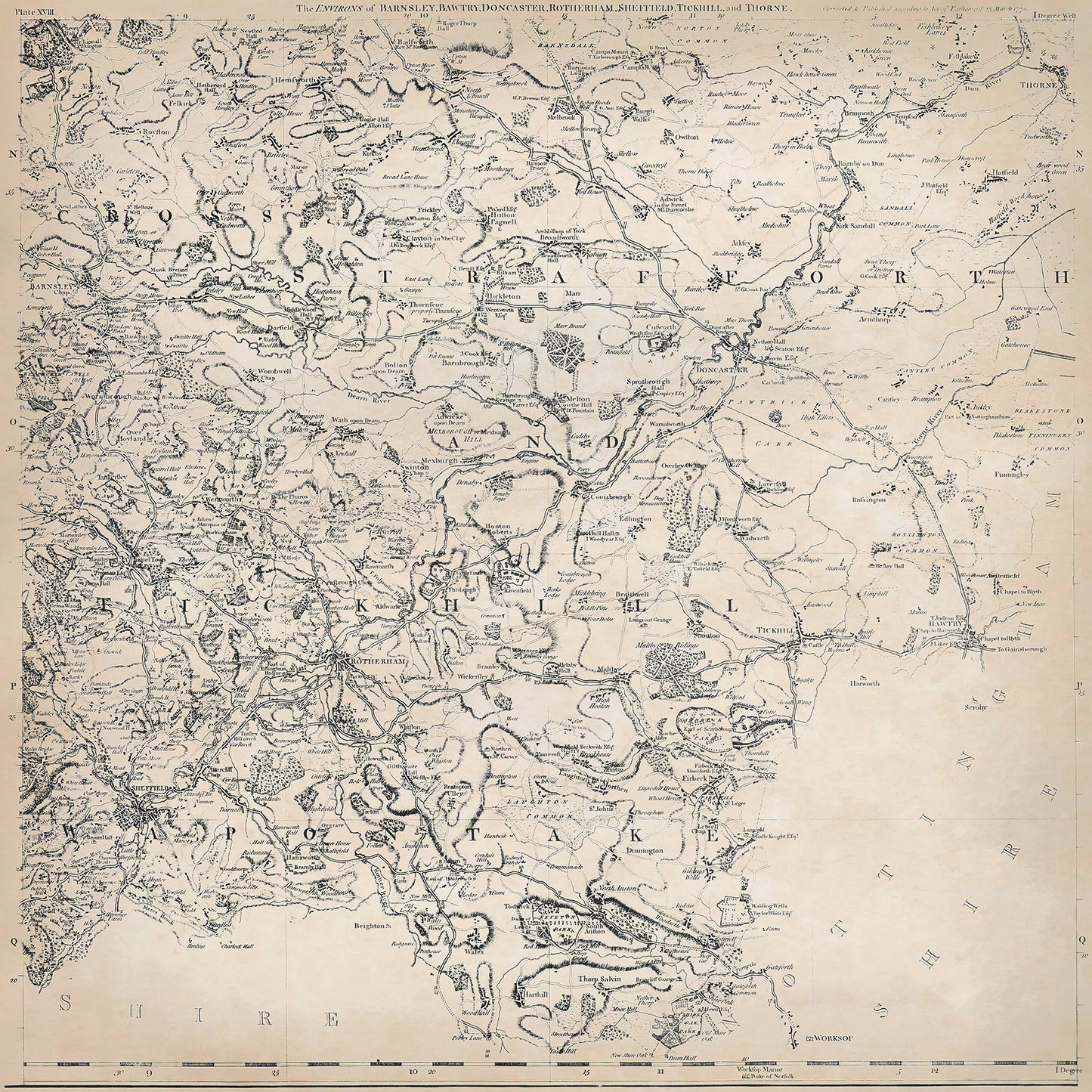Elite Wall Decor
Yorkshire in 1771 sheet 4-2 - shows the Barnsley, Bawtry, Doncaster, Rotherham, Sheffield, Tickhill and Thorne area
Yorkshire in 1771 sheet 4-2 - shows the Barnsley, Bawtry, Doncaster, Rotherham, Sheffield, Tickhill and Thorne area
Couldn't load pickup availability
Downloading this large file to phones or tablets is not recommended
This digital download is a high-quality 300dpi JPG image of one sheet from Thomas Jefferys "The County of York Survey'd" published in 1771. The image is crisp, clear and easy to read. It measures 60 x 60 cm, or 7087 x 7087 pixels but can be cropped or resized with the appropriate software. Download now to print whole or in part at home, or simply view it in close up on your device using image software such as Adobe Photoshop, Gimp, Windows Photo, or similar.
Barnsley:
Barnsley is a town located in South Yorkshire, known for its coal mining and industrial heritage.
During the late 18th century, Barnsley's local economy was centered around coal mining. The town had numerous coal mines and collieries, which provided employment for a significant portion of the population. Coal extraction and its subsequent use in industries such as ironworking and pottery were the main economic activities. Additionally, Barnsley had some cottage industries, including linen and textile production.
Barnsley's industrial heritage is reflected in its historic coal mines and mining artifacts. The town had several mining-related structures, such as pitheads and mine shafts. The Elsecar Heritage Centre, located nearby, showcases the history of coal mining and ironworking in the region. The town also had a few historic buildings and a local market.
Bawtry:
Bawtry is a small town located in South Yorkshire, known for its market and coaching heritage.
During the late 18th century, Bawtry's local economy was centered around its role as a market town. The town had a bustling market that attracted traders and visitors from the surrounding areas. Bawtry's location on major transportation routes, including the Great North Road, made it an important stop for stagecoaches and travelers. Some residents may have been involved in supporting industries such as hospitality, providing services to travelers and traders.
Bawtry's historic market square and market hall were central features of the town. The coaching inns, such as the Angel Inn, played a significant role in accommodating travelers and providing services. Bawtry also had a few historic buildings and a local church, adding to its charm as a market town.
Doncaster:
Doncaster is a town located in South Yorkshire, known for its horse racing heritage and historic market.
During the late 18th century, Doncaster's local economy was diverse. The town had a thriving horse racing industry, with the famous Doncaster Racecourse hosting races and attracting spectators. Doncaster also had a significant agricultural sector, with farming activities such as crop cultivation and livestock rearing. The town had some textile and pottery industries as well.
Doncaster's main attraction was the Doncaster Racecourse, which hosted prestigious horse racing events, including the St. Leger Stakes. The town's historic market, held in the market square, was a bustling hub of commerce. Doncaster also had several historic buildings, including Doncaster Minster, a notable landmark.
Rotherham:
Rotherham is a town located in South Yorkshire, known for its iron and steel industry.
During the late 18th century, Rotherham's local economy was centered around iron and steel production. The town had numerous ironworks and foundries that produced iron and steel products. Rotherham's strategic location on the River Don facilitated transportation of goods and raw materials. Additionally, the town had some coal mining and textile industries.
Rotherham's industrial heritage is evident in its historic ironworks and foundry buildings. The town had several notable landmarks, including Rotherham Minster, a medieval church. Rotherham also had a local market and a few historic buildings, showcasing its history and architectural charm.
Sheffield:
Sheffield is a city located in South Yorkshire, known for its renowned steel industry and cutlery production.
During the late 18th century, Sheffield's local economy revolved around the production of steel and cutlery. The town had numerous steelworks and cutlery workshops, where skilled craftsmen produced a wide range of cutlery and metal goods, including knives, scissors, and tools. Sheffield's reputation for quality craftsmanship and innovation in metalworking made it a leading center for the industry.
Sheffield had several places of interest in the late 18th century. The town's industrial heritage was reflected in its iconic workshops and factories. The Cutlers' Hall, built in 1832, served as a meeting place for the Company of Cutlers, a guild that regulated the cutlery trade. Sheffield also had historic churches, such as Sheffield Cathedral, and a local market that catered to both residents and visitors.
Tickhill:
Tickhill is a small market town located in South Yorkshire, known for its historic castle and agricultural activities.
During the late 18th century, Tickhill's local economy was primarily based on agriculture. The town and its surrounding area supported farming activities, including the cultivation of crops and rearing of livestock. Agriculture played a vital role in supplying the local market and nearby towns with food and raw materials.
Tickhill's main attraction was Tickhill Castle, a Norman castle that dates back to the 11th century. The castle, though in ruins, stood as a reminder of the town's medieval past and was a notable landmark. Tickhill also had a historic market square, where traders and locals gathered to exchange goods and services.
Thorne:
Thorne is a town located in South Yorkshire, known for its marshland and agricultural activities.
During the late 18th century, Thorne's local economy was primarily based on agriculture. The town's marshland provided fertile soil for farming activities, including the cultivation of crops and rearing of livestock. Agriculture was the main economic activity, supplying the local market and nearby towns with food and raw materials.
Thorne's notable feature was its surrounding marshland, which provided unique habitats for various wildlife species.

